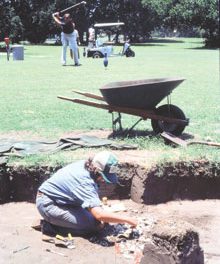Â
Just How Important Is Santa Elena?
If you live in Beaufort County you have to be confused. Within the last two years you have been introduced to something that you never heard about before…Santa Elena. Newspaper articles have said this about Santa Elena. “It was the capital of the first European settlement in what is now the United States.” “The first governor, Pedro Menendez de Aviles, was a real life John Wayne.” “He was governor of the Spanish colony of La Florida, which was not the state. La Florida extended from Newfoundland to the Keys and from the Atlantic Ocean to at least the Mississippi River.” And you have probably also seen the highway billboard signs that say, “Before Jamestown, Before Plymouth Rock, there was Santa Elena.” I informed you in my last article that the top two sixteenth century colonial historians in this country recommend that we slightly change those billboard to read, “Before Jamestown. Before Plymouth Rock. And before St. Augustine, there was Santa Elena.”
That is a great deal of information to digest in a short period of time. And it is counter to everything that we have been taught. So, let’s address the question. Is the Santa Elena site, and the La Florida story, as important as, say, Jamestown or Plymouth Rock? Let me give you my insights into those questions.
Since 1494 Spain believed that it had full possession of all undiscovered lands west of a longitude specified by the Pope’s Treaty of Tordesillas. But in the 1520’s Spain discovered vast silver in Mexico. Moreover, both France and Spain believed that there was another important undiscovered asset – the interior riches of North America, or what is now the United States. And both France and Spain knew that there was one preferred entrance to the interior – Punta Santa Elena, or Port Royal Sound.
Spain’s enemy, France, responded. They had to find a way to get some of those newfound riches. France had two options. One, they could license pirates to attack Spain’s treasure ships where they were most vulnerable. Or, two, they could create settlements on Spanish claimed North America. Spain’s diplomats responded by trying to reach an agreement with France that all French vessels were prohibited from trading at Spanish American ports. Spain also wanted a treaty that would prohibit France from creating any settlement on Spanish American soil. By 1560 the diplomats failed to agree on a compromise treaty. France made its decision. It would continue to license privateers to attack Spain’s ships. And it would also create settlements in Spain’s La Florida. But where would France establish its first colony?
Port Royal Sound (or Punta Santa Elena) had a double value to Spain. Spain had to protect its Treasure Fleets. It recognized that its ships were most vulnerable when they passed the mouth of Port Royal Sound while returning back to Spain. But Spain also saw Port Royal Sound as the point where it would establish its first major settlement. Santa Elena was destined to be the seaport for discovering the interior of what would become the United States. However, France had similar thoughts.
By 1545 French licensed pirate ships (i.e. privateers) were actively ambushing Spanish ships in the Caribbean and off of Northern Spain.
This accelerated Spain’s interest in protecting the Treasure Fleet. It also reminded them that their preferred inland port of Punta Santa Elena, or Port Royal Sound, was not yet settled and protected.
By 1557 the Viceroy of Mexico (Spain called it New Spain) recommended an action that underscored Santa Elena’s importance to the Crown. Spain’s Mexican Viceroy, Don Luis de Velasco, was having increasing problems in his colony of New Spain (Mexico). His soldiers were becoming overworked and restless. The viceroyalty had experienced a devastating epidemic that killed approximately 60% of the Indian population. Much of their burden was shifted to the soldiers. And they became increasingly rebellious. Viceroy Velasco proposed that he create a secondary settlement along the Gulf side of La Florida. He framed-out their mission this way: We will create several settlements that can absorb our restless soldiers, provide a refuge for shipwrecked victims, and spread the conversion of the Indians. Furthermore, this new colony would prevent the French from validating their clam to this land. However, once King Philip saw the proposed plan, he demanded one big change. On December 29, 1559, he issued an order to the Viceroy that said, “As part of your plan you will establish a Spanish colony on the Punta Santa Elena (i.e., Port Royal Sound) without further delay. We have learned that Frenchmen might attempt to colonize La Florida under cover of voyages to the (Canadian) cod fisheries.”
Viceroy Velasco changed his mission statement. He now ordered Tristan de Luna to mount an expedition to settle the North American Gulf. As part of that plan he would create settlements at what is now Pensacola, Coosa (northwest Georgia) and Santa Elena. Then, the viceroy agreed to link these three settlements together. There would be a planned road from Pensacola to Santa Elena. That would allow Spain to move its treasure fleet bullion overland to Santa Elena. That inland road would help Spain bypass the French pirates and the fall hurricane threat.
The colony failed. A hurricane decimated the Viceroy’s fleet when he landed at Pensacola. His people found little food. By 1561 they had abandoned their attempt to establish a new colony and to link Pensacola with Santa Elena. As a footnote, the Pensacola Chamber of Commerce has promoted itself as “The First European Settlement.” However, no historian has ever stated that it was anything but a failed attempt. In fact, King Philip II of Spain called it a failed attempt.
Next issue: France implements the second part of its strategy to penetrate Spain’s claim on what is now the United States.
Â









